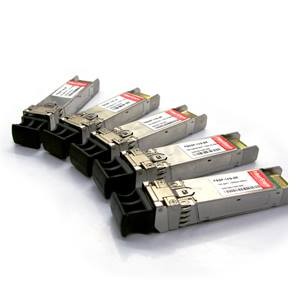The optical transceivers can be integrated or pluggable.
An integrated transceiver is built into the network interface on a line card, HBA, TOE, or NIC such that it cannotbe replaced if it fails. This means the entire interface must be replaced if the transceiver fails. For switch line cards, this implication can be very problematic because an entire line card must be replaced to return a single port to service when a transceiver fails.
Also, the type of connector used to mate a cable to an interface is determined by the transceiver. So, the types of cable that can be used by an interface with an integrated transceiver are limited. An example of an integrated transceiver is the traditional 10/100 Ethernet NIC, which has an RJ-45 connector built into it providing cable access to the integrated electrical transceiver.
By contrast, a pluggable transceiver incorporates all required transmit/receive componentry onto a removeable device. The removable device can be plugged into an interface receptacle without powering down the device containing the interface (hot-pluggable). This allows the replacement of a failed transceiver without removal of the network interface. For switch line cards, this enables increased uptime by eliminating scheduled outages to replace failed transceivers.
Also, hot-pluggable transceivers can be easily replaced to accommodate cable plant upgrades. In exchange for this increased flexibility, the price of the transceive is increased. This results from an increase in research and development (R&D) costs and componentry. Pluggable transceivers are not always defined by networking standards bodies. Industry consortiums sometimes form to define common criteria for the production of interoperable, pluggable transceivers. The resulting specification is called a muti-source agreement (MSA). The most common types of pluggable transceivers are Giga Bit Interface Converter (GBIC) and Small Form-factor Pluggable (SFP).

A GBIC or SFP can operate at any transmission rate. The rate is specified in the MSA. Some MSAs specify multi-rate transceivers. Typicaly, GBICs and SFPs are not used for rates below 1 Gbps. Any pluggable tranceiver that has a name beginning with the letter X operates at 10 Gbps. The currently available 10-Gbps pluggable transceivers include 10 Gigabit small Form-factor Pluggable (XFP), XENPAK, XPAK, and X2.
XENPAK is the oldest 10 Gigabit MSA. The X2 and XPAK MSAs build upon the XENPAK MSA. Both X2 and XPAK use the XENPAK electrical specification. XFP incorporates a completely unique design.
About the Author:
I am working in Fiberstore to share the fiber optic networking knowledges and products’ information with people. Fiberstore is a largest supplier of optical network solutions worldwide. You can get the cheapest compatible SFP+ modules here. Welcome to visit our website www.fs.com!



